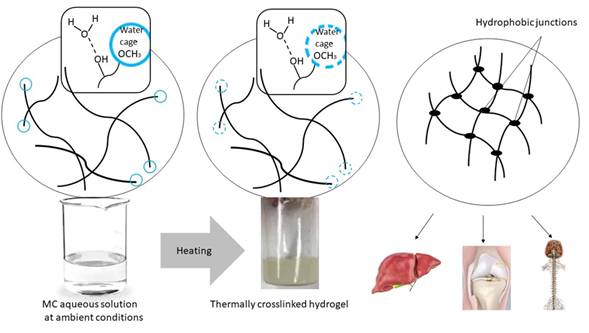The PRELUDIUM 15 grant is provided by the Polish National Science Center (NCN), “Thermosensitive hydrogels filled with bioactive nanofibers for regeneration of neural tissue”, grant number 2018/29/N/ST8/00780.
Hydrogels are a group of polymers that are very attractive from the perspective of tissue engineering. They form three-dimensional networks in aqueous environments by absorbing and retaining large amounts of water in the structure. They are biocompatible, easily processable, and physically resemble native ECM. Currently, smart stimuli-responsive hydrogels enjoy great interest. Under external stimulation, they might present changes in swelling behavior, electrical conductivity or show reversible sol-gel transition. The hydrogels might respond to external stimuli such as pH, ultraviolet radiation, electricity, magnetic fields, or temperature.
Nevertheless, hydrogels usually have poor mechanical properties and do not possess a fibrous structure that could mimic protein fibers in native ECM and provide additional support for cell activity. Obtaining hydrogel composites with enhanced mechanical properties and short fibers might overcome these limitations.
Thereby, the project's objective is to design smart injectable material as a scaffold for native neural tissue engineering applications. The composition and fabrication process provides material properties, which on the one hand, assure injectability and, on the other, after injection, mimic the neural extracellular matrix (ECM). To accomplish the goal, it is necessary to select ingredients, composition, and fabrication process to obtain smart injectable thermosensitive cross-linkable substrate, which transforms after injection at the condition of near-physiological temperature, at the appropriate time, into the neural ECM-like oriented cross-linked product.
The hydrogel system consists of methylcellulose and agarose solutions. Methylcellulose (MC) is methylated cellulose, in which the hydroxyl groups are substituted with the methoxy groups. The substitution prevents crystals formation, which is present in cellulose, making MC water-soluble. MC offers many advantages, i.e., it is not toxic for cells, stable in physiological environments and cell-culture media. MC's mechanical properties might be easily tailored, by adjusting its concentration, to make it suitable for various native tissues. MC undergoes thermal reversible crosslinking near the physiological temperature as a consequence of the hydrophobic domain formation. The crosslinking mechanism is divided into two stages. At room temperature, polymer-solvent interactions between hydrophilic MC groups and water dominate in the solution. The hydrophobic molecules are surrounded by water cages or so-called water clusters as a result of weak polymer-polymer interactions. While the temperature increases near the physiological temperature, water cages are shattered and the hydrophobic regions of MC are exposed leading to stronger polymer–polymer interactions, and subsequent formation of hydrophobic interactions. This is the 1st step of crosslinking, which is a specific type of dehydration. The 2nd stage assumes the generating of a hydrophobic three-dimensional fibril network.
The other hydrogel component is agarose, which is a purified linear galactan hydrocolloid derived from marine algae. Agarose has a greater affinity to water than MC. It accelerates MCs dehydration and enhances MSC's mechanical properties.
The hydrogels properties were enriched biomechanically by introducing short bioactive fibers. The poly(l-lactic acid) (PLLA) fibers were formed via electrospinning, fragmented via ultrasonication, and subsequently modified with laminin by physical adsorption. Laminin immobilization allowed to increase hydrophilicity and overcome biochemical inertia of PLLA by providing IKVAV (Ile-Lys-Val-Ala-Val) effective sites for cell adhesion. As one of the ECM components, laminin contains protein receptors, which are decent, especially from the perspective of neural cells.

Niemczyk-Soczyńska B., Gradys A., Kołbuk D., Krzton-Maziopa A., Sajkiewicz P., Crosslinking kinetics of methylcellulose aqueous solution and its potential as a scaffold for tissue engineering, Polymers, ISSN: 2073-4360, Vol.11, No.11, pp.1772-1-17, 2019
